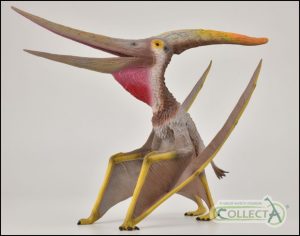Pteranodon Fossils Found In Texas
New Pterosaur perhaps the Oldest Known Pteranodontidae from Texas
Texas, the second biggest state in the United States is a part of the world where things can be found on a very large scale. From amazing sporting arenas such as the Dallas Cowboys stadium to huge portions of fries served up at some of their highway restaurants and from our perspective, some spectacular dinosaur body and trace fossils. Added to this heady mix is a set of remarkable Pteranodon fossils.
In terms of Pterosauria, the huge azhdarchid pterosaur, arguably the largest known to science, Quetzalcoatlus (Q. northropi) heralds from that part of the world, but thanks to the hard work of one American amateur scientist an important new pterosaur discovery can be added to the fossil record of the lone star state. It is not the size of this pterosaur that is important, although only a portion of the entire skeleton was found, it has been estimated that this flying reptile had a wingspan of around 4 metres, it is the age.
Pteranodon Fossils
This new specimen, most probably representing a new species of Pteranodon was found in marine strata dating from approximately 89 million years ago (Turonian faunal stage). This would make it the oldest known specimen of a pteranodon ever found in North America.
Pterosaurs are an extinct group of flying reptiles, with no close living relatives. Their wings were formed by a stretched membrane of skin that was supported by an elongated fourth digit. The wings extended along the arms and down the body and these creatures dominated the skies for much of the Mesozoic and in some cases evolved into giant forms, the largest flying animals ever.
The fossilised bones were discovered by amateur palaeontologist Gary Byrd as a new culvert drain was being excavated north of Dallas. It appears that this poor unfortunate creature, was flying over the Western Interior Seaway, when for some reason it crashed into the sea. It probably drowned and the corpse sank to the bottom where over time it was covered with sediment and preserved as a fossil.
Commenting on his discovery, Gary stated:
“I found a couple of parts from a fish, and then when I saw these [pterosaur bones] my initial thought was that they were not fish. I knew it was something different, a bird-like thing. It is very rare to find those long, thin bones.”
He donated his discovery to Southern Methodist University’s Museum of Palaeontology and scientists at the museum identified the bones as belonging to the left wing of a member of the Pteranodon genus.
A Model of a Pteranodon Flying Reptile (CollectA Pteranodon Figure)
In a statement issued by the University, one of the palaeontologists responsible for the analysis of the fossil material said:
“It it wasn’t crushed so badly, it would be possible to determine if it really is a Pteranodon. These bones are easily flattened. They are hollow inside, because they have to be lightweight to allow a pterosaur to fly, so they compress like a pancake as they are embedded in layers of rock.”
To view the range of pterosaur figures available in the CollectA Deluxe scale model series: CollectA Deluxe Prehistoric Life Models.
Certain structures on the bone suggest this was indeed a member of the Pteranodon genus. It had, for example, a “prominent warped deltopectoral crest” characteristic of members of the Pteranodontidae family.
Before this discovery, these type of pterosaurs were known from other parts of the United States, most notably Kansas, but this specimen pre-dates the oldest found in the USA by at least 1.5 million years. If this specimen is proved to be a true member of the Pteranodon genus then it is in the running to be the oldest known example of this genus in the world.
If this Texas fossils proves to be an actual Pteranodon, it will be the oldest example of the species in the world.
This new specimen also lived at an important time of transition for pterosaurs. During this time, around 80-90 million years ago, the winged reptiles were diversifying from toothed forms to toothless varieties like the Pteranodons and the Azhdarchidae.
A spokesperson commented:
“This new specimen adds a lot more information about pterosaurs in North America. It helps constrain the timing of the transition from toothed to toothless because there’s only a few million years separating this specimen and Aetodactylus.”.
Aetodactylus was a toothed pterosaur (Aetodactylus halli). Its fossils have been found in north-eastern Texas and the strata from which the fossils were excavated has been estimated to be around 95 million years old (Cenomanian faunal stage).


